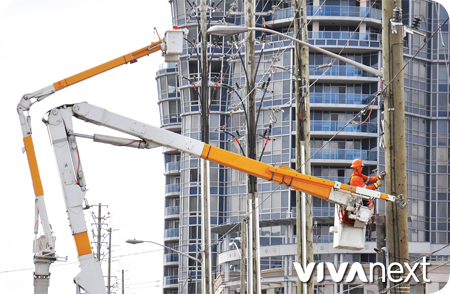If we were building our vivaNext rapidways across undeveloped fields, widening the roadway to incorporate the median bus lanes would be a straightforward construction project involving excavation, building the road base and drainage system, boulevard and station construction, installing illumination, and paving. But, in all our projects, there are many existing utilities along the roadways that need to be moved first. Believe it or not, this part of the project – relocating existing utilities – can sometimes result in the greatest amount of complexity and schedule coordination. Here’s a primer on why this least-obvious part of the project can be so time-consuming, but is so critical, yet so complicated.
Utilities – which on our projects include a wide number of companies providing electricity, telecommunications, cable and gas – are typically private entities, which in some cases have connections to local municipalities, and in other cases are private for-profit organizations. In all cases, utilities own their own infrastructure and are responsible for designing, installing, paying for, and maintaining it. Utilities have direct relationships with their own customers, and have to plan for, manage and respond to service interruptions.
With so many users relying on the services along the roadway corridors, we need to work together before we can widen the roadway for the vivaNext project. A first step is to identify existing utilities, to confirm what has to be moved out of the way. To complete this first step, we collect all the information we can, including “as-builts,” which are drawings showing the location of existing utilities. Using the as-builts [and sometimes ground penetrating radar], we then carry out physical locates, where we dig small test pits to confirm that utilities are where we think they are, and what condition they’re in.
Once there is agreement on which utilities need to be moved, each company designs a new alignment for their service, or designs a shared structure such as an underground duct bank, with another company. These relocation designs have to work with our project’s requirements and dimensions [and our project’s design has to provide for a reasonable relocation design for the utilities], as well as with the alignments of all the other utilities. Just completing the design coordination and review alone is a complex and iterative process.
With the utility relocation designs complete, municipalities and other approval bodies such as the Ministries of Environment and Natural Resources and local conservation authorities – and railway companies where rail crossings are involved – review, comment on, and hopefully approve the plans. In many cases, private property owners also need to agree to provide access to the utility companies, adding yet another layer of complexity and coordination.
The final stage is the actual construction of the relocated utilities. Because there are strict construction rules about the separation required between crews, we work carefully to sequence the relocation work.
The roadway widening cannot be completed until utility relocations are finished in any given area. And as in any activity where multiple organizations have operations underway, we all need to work together collaboratively, and coordinating our efforts is critical, so we can get the rapidways built and in service for you. Like I said….complicated!

